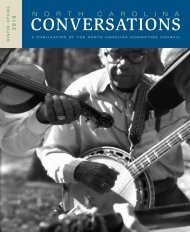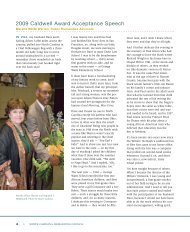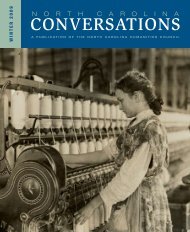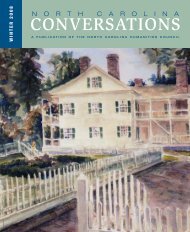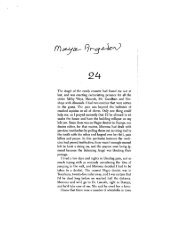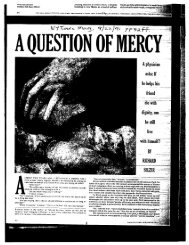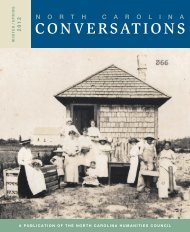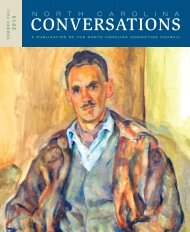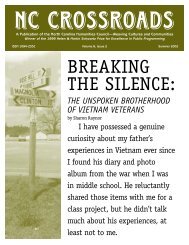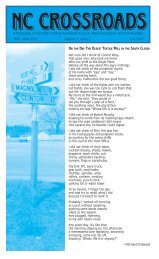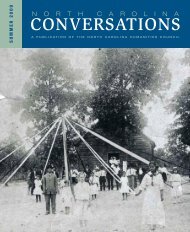North Carolina Conversations Summer-Fall 2008.pdf
North Carolina Conversations Summer-Fall 2008.pdf
North Carolina Conversations Summer-Fall 2008.pdf
- No tags were found...
You also want an ePaper? Increase the reach of your titles
YUMPU automatically turns print PDFs into web optimized ePapers that Google loves.
Confessionsof an AccidentalDocumentarianLawrence S. EarleyTwo fishing boats. One issecured to the dock while a secondapproaches. I took this photographin 1985 while exploring the fishingvillages on the peninsula northeastof Beaufort, <strong>North</strong> <strong>Carolina</strong>, an areaknown as “Down East.” It’s an artlessphoto, with little in its compositionor lighting to distinguish it. In fact, Inever bothered to print it until 2004when I was asked to show some ofmy workboat photographs at the CoreSound Waterfowl Museum on HarkersIsland, <strong>North</strong> <strong>Carolina</strong>. I titled it“Workboats, Core Sound, 1985.”During the festival, I noticed thata few men had stopped in front of“Workboats, Core Sound, 1985” andstudied it intently. One of them toldme that he had worked on one of thevessels; it was a boat he knew well.Another said that his father ownedthe boat on the right, which wascalled the Wasted Wood. Two othersstood in front of it, talking quietly.One of them, a boat builder by thename of Jimmy Amspacher, said hewas building a model boat like thetwo boats in the photograph. Then,in the distinctive brogue of a DownEaster, he told me about the scenethat I had photographed in 1985.The boat on the right was the WastedWood, he said, although it could wellhave been the Nancy Ellen. The boaton the left was definitely the Linda.Both of them were built in Atlantic— he called them “Atlantic-builtboats” — a fact that was evident intheir styling. Because each communityin the region was fairly isolatedfrom the others before the coming ofroads and bridges, communities hadFrom its very beginning, a workboat lay at the center of a social web that linked the builder, theowner, the person for whom the boat was named, and the place where she was built. Photo byLawrence S. Earley.distinct workboat styles based ontradition and the influence of importantlocal boat builders. Both boats inthe photo were used to do a particularkind of fishing called long-haulfishing which was characteristic ofAtlantic’s fishermen. The photographhad a new title now: “Wasted Woodand Linda, Atlantic, 1985.”Jimmy Amspacher spent five minutestelling me what was in my photograph,and when he was finished,I had learned an important lesson:I was blind to the very things thatmade the photo interesting to thelocal people. To me, the photographwas an ordinary snapshot; to them,the photograph was layered withstories — historical, biographical,technological, and environmental.My “snapshot” was a portal thatopened into a world with hiddendepths revealing multiple humanrelationships. The boats that Ihad photographed as aestheticallypleasing parts of the landscape wereso much more than that.Many things in the photograph havechanged since I took the picturetwenty-three years ago. The WastedWood went to pieces in 1998 or 1999.The weather-beaten Linda still sits atthe Luther L. Smith Seafood docks,but she is decrepit now and unused;her paint is pealing and debris isstrewn over her deck. The last timeI saw her, she was half sunk afterthe bailing pump had failed. In the1990s, a hurricane destroyed thewooden docks in the photograph.In March 2008, at the symposiumon the “Workboats of Core Sound,”Jonathan Robinson spoke as one ofthe panelists. Jonathan’s openingwords were mournful:I came here today expecting tosee some photographs of the oldboats that Larry Earley has beentaking for some time and I waslooking forward to it. But as Ilooked at the photos I becamesad. I know these boats and Iknow the people who workedthem, and when I see themand read the words of people Iknow it seems that what we’redoing here today is like visitinga dying person in the hospitaland trying to extract as muchinformation from him before hepasses away....My photographs brought him face-tofacewith a world that he knew andloved but that was dying. It was afear that he and others had admittedto themselves for years; it was somethingthey told me over and overagain in my interviews. But to see itin pictures was a little like looking inthe mirror in a strange light and notrecognizing yourself.NC <strong>Conversations</strong> • <strong>Summer</strong> 2008 • 13



